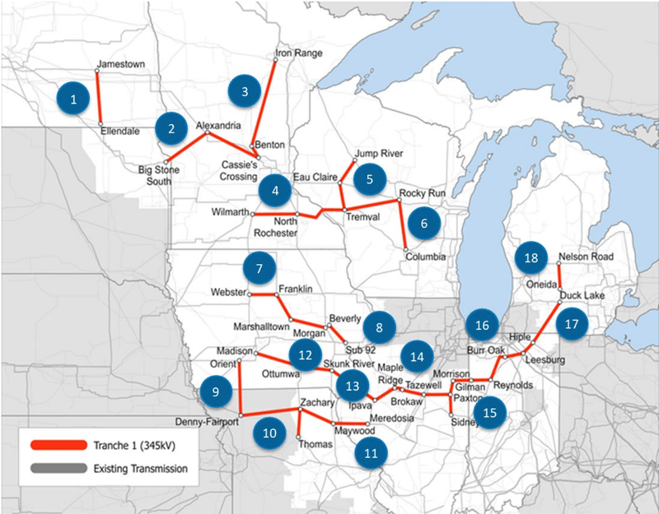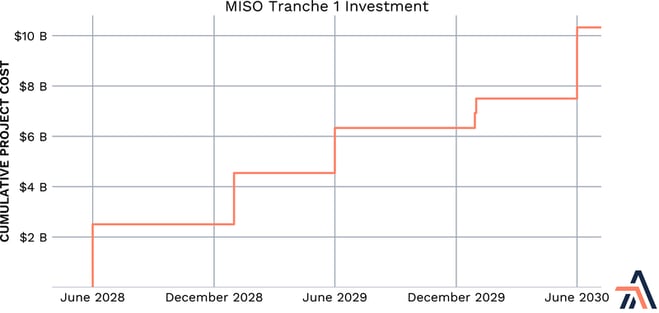MISO’s Tranche 1 Portfolio Sets the Pace for Upcoming Transmission Planning Marathon
Originally published for customers June 9, 2023
What’s the issue?
The Midcontinent Independent System Operator (MISO) recently approved its Tranche 1 Portfolio, the first of four tranches under MISO’s Long Range Transmission Planning efforts to ensure a reliable, resilient and cost-effective transmission system.
Why does it matter?
The success of the energy evolution in the United States is heavily dependent on the state of the broader electric transmission grid, which needs to be both upgraded and expanded in order to support the expected additions of renewable capacity. MISO’s first of their kind transmission planning efforts have the potential to guide the transmission buildout and prioritization in other regions across the country.
What’s our view?
Long range transmission planning is a much-needed effort to achieve a carbon-free power sector. The process is lengthy and expensive, and other regions have not taken the necessary steps to begin their expansion plans in order to achieve a carbon-free power sector by 2035.
The Midcontinent Independent System Operator (MISO) recently approved its Tranche 1 Portfolio, the first of four tranches under MISO’s Long Range Transmission Planning (LRTP) efforts to ensure a reliable, resilient and cost-effective transmission system. The energy evolution in the United States is heavily dependent on the state of the broader electric transmission grid, which needs to be both upgraded and expanded in order to support the expected additions of renewable capacity. MISO’s first of their kind transmission planning efforts have the potential to guide the transmission buildout and prioritization in other regions across the country.
Long-range transmission planning is a much-needed effort to achieve a carbon-free power sector. The process is lengthy and expensive, and other regions have not taken the necessary steps to begin their expansion plans to achieve a carbon-free power sector by 2035.
MISO’s Tranche 1 Portfolio
The success of the energy evolution is heavily dependent on the addition of significant amounts of renewable energy generation and associated transmission lines to transport electricity from where it is generated to where it is needed. As we discussed in MISO Shows Reforms Are Desperately Needed to Interconnection Queueing, MISO’s interconnection queue is significantly backlogged and will lead to lengthy timelines for generation projects throughout the region. This situation is not unique, and the other independent system operators (ISO) and regional transmission organizations (RTO) are all facing a similar situation. Where MISO stands out, however, is in its transmission planning efforts. MISO is the only one of the major ISOs/RTOs in the United States that has taken significant steps towards a region-wide expansion of its transmission grid with the recent approval of its Tranche 1 Portfolio.

Source: MISO
As seen in the map above, the Tranche 1 Portfolio consists of 18 separate transmission projects within MISO’s Midwest subregion, though many of the individual projects will end up connecting with one another. Each of the 18 projects in the portfolio will be a new 345kV line and will provide over 2,000 miles of new transmission in the region. The current plan is to place these projects into service over a two-year period, with the first lines going into service in June 2028 and the remaining going into service incrementally through June 2030.

The chart above shows the significant investment that it will take to complete these projects. Once every project is in service, the total cost to complete the portfolio is estimated to be over $10 billion. Of course, that figure does not demonstrate the full magnitude of this effort. The first meetings to begin the planning process took place in August 2020, meaning that, from start to finish, the first phase alone will have taken over 10 years to complete. It is important to note this timing when considering President Biden’s goal of a carbon-free power sector by 2035. MISO’s Midwest subregion has likely taken the right steps to have the transmission needed to support the growth of renewable generation in the same area. The rest of the country, however, is lagging behind. If large-scale regional planning efforts aren’t undertaken soon, the chances of nationwide transmission expansion by 2035 are slim to none.
Tranche 2 and Beyond
The Tranche 1 portfolio is just one of four tranches in MISO’s LRTP efforts. Tranche 2 is currently under development. Like Tranche 1, it is also focused on the Midwest subregion, but the goal of the second tranche is to improve interconnection. Planning efforts for the second phase began in the fourth quarter of 2022, and the portfolio is expected to be approved in the first half of 2024. One of the key factors being considered during planning is whether or not to use higher voltage transmission lines, such as 765kV or High-Voltage Direct Current lines. Because these lines have significantly higher capacity than the ones used in Tranche 1, the projects have a lower cost and require less land usage per MW of capacity. Tranche 2 is expected to be significantly larger than the first tranche, with costs currently estimated to be between $20 and $30 billion.
Tranches 3 and 4 have been established but the planning efforts have not started yet. Tranche 3 will be focused on the South subregion, and Tranche 4 will focus on the connections between the North and South subregions. The total cost of all four tranches is estimated at close to $100 billion. Meanwhile, FERC hasn’t taken a final action since issuing its Transmission Planning Notice of Proposed Rulemaking in 2022, and any rule adopted could influence MISO’s planning process for the next tranches.
A Framework for Long Range Transmission Planning
MISO is leading the way and has created a model other ISOs and RTOs can follow for long range transmission planning efforts. Each of the four portfolios will be developed following the same seven-step process detailed below, unless FERC does not establish any new rules for transmission planning.
- Develop scenario-based “Futures” — MISO’s forward-looking planning reports that provide insight into future requirements — with load forecast, generation forecast, and siting results.
- Develop models utilizing Futures and test system performance.
- Identify potential transmission issues.
- Propose solutions to issues.
- Develop models with proposed solutions and evaluate the effectiveness of various solutions.
- Recommend preferred solutions for MISO Transmission Expansion Plan implementation.
- Apply appropriate cost allocation.
The planning process takes a top-down approach and, when laid out in the above steps, is relatively simple in theory. One of the biggest challenges in the portfolio planning process is the uncertainty surrounding the future generation mix in the region, an issue that is not unique to MISO. Addressing this issue in the first step means that it will be considered in all subsequent steps, so it will not hinder the planning process further down the line.
Generation mix and specific load needs differ from one region to the next, but every region has the same general need: expansion of the grid to meet new generation and reliability concerns. The planning process will not be easy or quick, but MISO’s efforts provide a framework that the other ISOs and RTOs can follow and adjust to their specific goals.